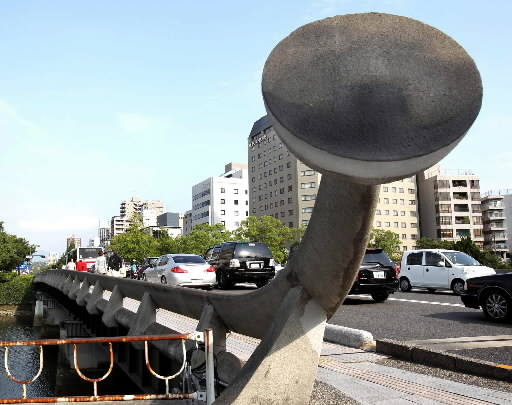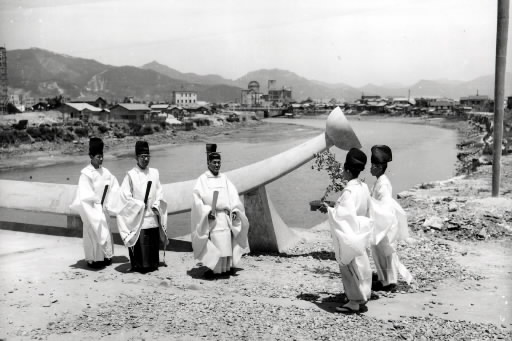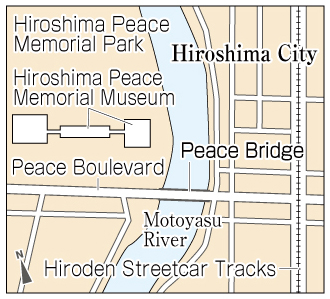Concrete railings of Peace Bridge to be restored to original appearance by fiscal 2017
Aug. 6, 2013
by Aya Kno, Staff Writer
The City of Hiroshima has decided to restore the railings of Peace Bridge, making their appearance similar to the original as-cast concrete. Peace Bridge, designed by celebrated sculptor Isamu Noguchi (1904-1988) and completed in 1952, is a symbol of Hiroshima’s reconstruction from the atomic bombing. When the bridge was repaired 30 years ago, the railings were sprayed with fieldstone paint. Mr. Noguchi expressed disappointment at the resulting change in texture. This time, the restoration work will be pursued in conjunction with the building of a pedestrian bridge alongside Peace Bridge. The work on these projects is expected to be completed in fiscal 2017.
Peace Bridge, which spans the Motoyasu River and part of Peace Boulevard, is 85.5 meters long and 15 meters wide. Its railings curve upward at the ends of the bridge, and on either end is a hemisphere which represents the sun, a symbol of strength and vitality. The bridge leads to Hiroshima Peace Memorial Park.
When the bridge was completed, the surface of the railings was bare, as-cast concrete. With the passage of time, however, there was deterioration to the degree that the iron frame in one of the railings became exposed.
The city government then carried out repair work on the bridge to protect the surface of the railings by spraying paint which left the rough texture of fieldstone. When Mr. Noguchi visited Hiroshima in 1984, he said he understood the need to perform repairs, but the work had left the railings with a different texture and the edges of the concrete had become rounded off with age.
Since the sidewalks of Peace Bridge are only 1.8 meters wide, the city has decided to build a pedestrian bridge to the north. The pedestrian bridge will be completed, at the earliest, in fiscal 2017.
Taking the opportunity presented by this new construction, the city plans to restore the original appearance of the bridge’s railings so that the public can see their original appearance. First, the paint will be removed from the railings, which will then be treated to restore their former state. The surface will be finished with silicon resin and pigment to help make the railings more durable. The specifics of methods and costs are currently under discussion.
Masatoshi Izumi, 74, director of the Isamu Noguchi Foundation, based in Takamatsu, Kagawa Prefecture, said, “Mr. Noguchi designed this bridge expressly for Hiroshima. It is gratifying that the bridge will regain its original form.”
Keywords
Peace Bridge
Peace Bridge consists of two bridges. The eastern Peace Bridge, mentioned above, and the western Peace Bridge, which spans the Honkawa River, were completed in 1952. The construction was pursued under the direct authority of the Japanese government, which financed the construction costs, totaling 110 million yen, by selling relief supplies provided by the United States. Mr. Noguchi’s design fee of 500,000 yen was covered by the City of Hiroshima. Opinions were divided, among municipal assembly members, over Mr. Noguchi’s novel designs. Some praised the designs as a fitting symbol of Hiroshima, while others argued that the railings looked like caterpillars and that children would be in danger of falling off the bridge into the river.
(Originally published on August 4, 2013)
The City of Hiroshima has decided to restore the railings of Peace Bridge, making their appearance similar to the original as-cast concrete. Peace Bridge, designed by celebrated sculptor Isamu Noguchi (1904-1988) and completed in 1952, is a symbol of Hiroshima’s reconstruction from the atomic bombing. When the bridge was repaired 30 years ago, the railings were sprayed with fieldstone paint. Mr. Noguchi expressed disappointment at the resulting change in texture. This time, the restoration work will be pursued in conjunction with the building of a pedestrian bridge alongside Peace Bridge. The work on these projects is expected to be completed in fiscal 2017.
Peace Bridge, which spans the Motoyasu River and part of Peace Boulevard, is 85.5 meters long and 15 meters wide. Its railings curve upward at the ends of the bridge, and on either end is a hemisphere which represents the sun, a symbol of strength and vitality. The bridge leads to Hiroshima Peace Memorial Park.
When the bridge was completed, the surface of the railings was bare, as-cast concrete. With the passage of time, however, there was deterioration to the degree that the iron frame in one of the railings became exposed.
The city government then carried out repair work on the bridge to protect the surface of the railings by spraying paint which left the rough texture of fieldstone. When Mr. Noguchi visited Hiroshima in 1984, he said he understood the need to perform repairs, but the work had left the railings with a different texture and the edges of the concrete had become rounded off with age.
Since the sidewalks of Peace Bridge are only 1.8 meters wide, the city has decided to build a pedestrian bridge to the north. The pedestrian bridge will be completed, at the earliest, in fiscal 2017.
Taking the opportunity presented by this new construction, the city plans to restore the original appearance of the bridge’s railings so that the public can see their original appearance. First, the paint will be removed from the railings, which will then be treated to restore their former state. The surface will be finished with silicon resin and pigment to help make the railings more durable. The specifics of methods and costs are currently under discussion.
Masatoshi Izumi, 74, director of the Isamu Noguchi Foundation, based in Takamatsu, Kagawa Prefecture, said, “Mr. Noguchi designed this bridge expressly for Hiroshima. It is gratifying that the bridge will regain its original form.”
Keywords
Peace Bridge
Peace Bridge consists of two bridges. The eastern Peace Bridge, mentioned above, and the western Peace Bridge, which spans the Honkawa River, were completed in 1952. The construction was pursued under the direct authority of the Japanese government, which financed the construction costs, totaling 110 million yen, by selling relief supplies provided by the United States. Mr. Noguchi’s design fee of 500,000 yen was covered by the City of Hiroshima. Opinions were divided, among municipal assembly members, over Mr. Noguchi’s novel designs. Some praised the designs as a fitting symbol of Hiroshima, while others argued that the railings looked like caterpillars and that children would be in danger of falling off the bridge into the river.
(Originally published on August 4, 2013)










